HI6025 Trimester 2: Accounting for Intangibles Report
VerifiedAdded on 2023/06/07
|9
|2253
|342
Report
AI Summary
This report analyzes two articles related to the accounting for intangibles, examining their purposes, similarities, and differences. The first article focuses on the importance of recognizing intangible assets in financial statements and the consequences of their omission. The second article investigates the impact of adopting International Financial Reporting Standards (IFRS) and Australian Accounting Standards (AGAAP) on the value relevance of intangibles. The report explores the implications of these articles for various stakeholders, including accountants, accounting regulators, and investors. It concludes that the proper accounting treatment of intangibles is crucial for reflecting a company's true financial position and making informed decisions. Both articles highlight the growing significance of intangibles in the modern economy and emphasize the need for improved accounting standards and disclosure practices. The report also discusses how the adoption of accounting standards related to intangibles can improve market efficiency and decision-making for businesses and investors. The findings of this report can help with the preparations required for the successful adoption and reflection of intangible accounting standards.

Accounting for Intangibles
1
1
Paraphrase This Document
Need a fresh take? Get an instant paraphrase of this document with our AI Paraphraser
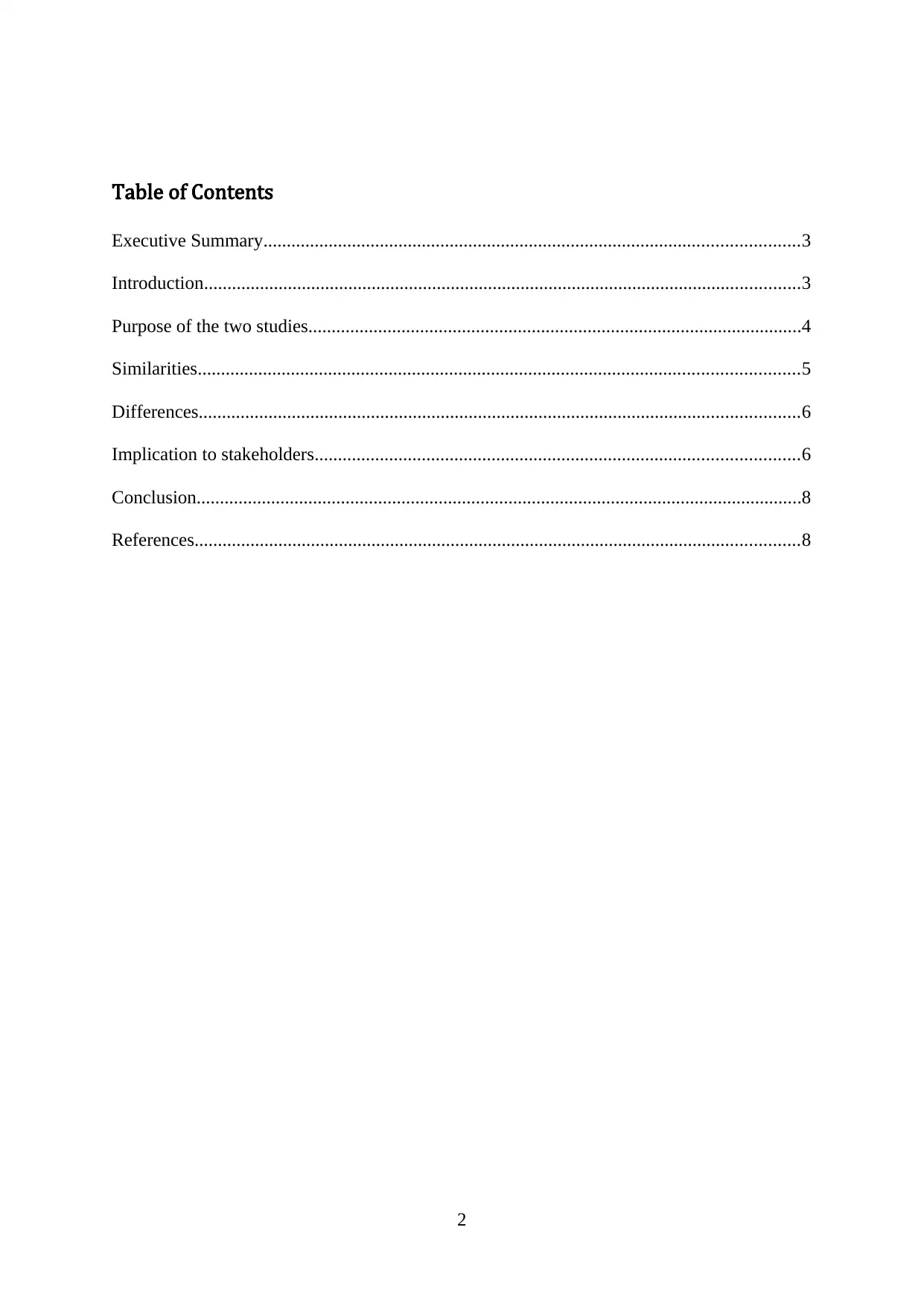
Table of Contents
Executive Summary...................................................................................................................3
Introduction................................................................................................................................3
Purpose of the two studies..........................................................................................................4
Similarities.................................................................................................................................5
Differences.................................................................................................................................6
Implication to stakeholders........................................................................................................6
Conclusion..................................................................................................................................8
References..................................................................................................................................8
2
Executive Summary...................................................................................................................3
Introduction................................................................................................................................3
Purpose of the two studies..........................................................................................................4
Similarities.................................................................................................................................5
Differences.................................................................................................................................6
Implication to stakeholders........................................................................................................6
Conclusion..................................................................................................................................8
References..................................................................................................................................8
2
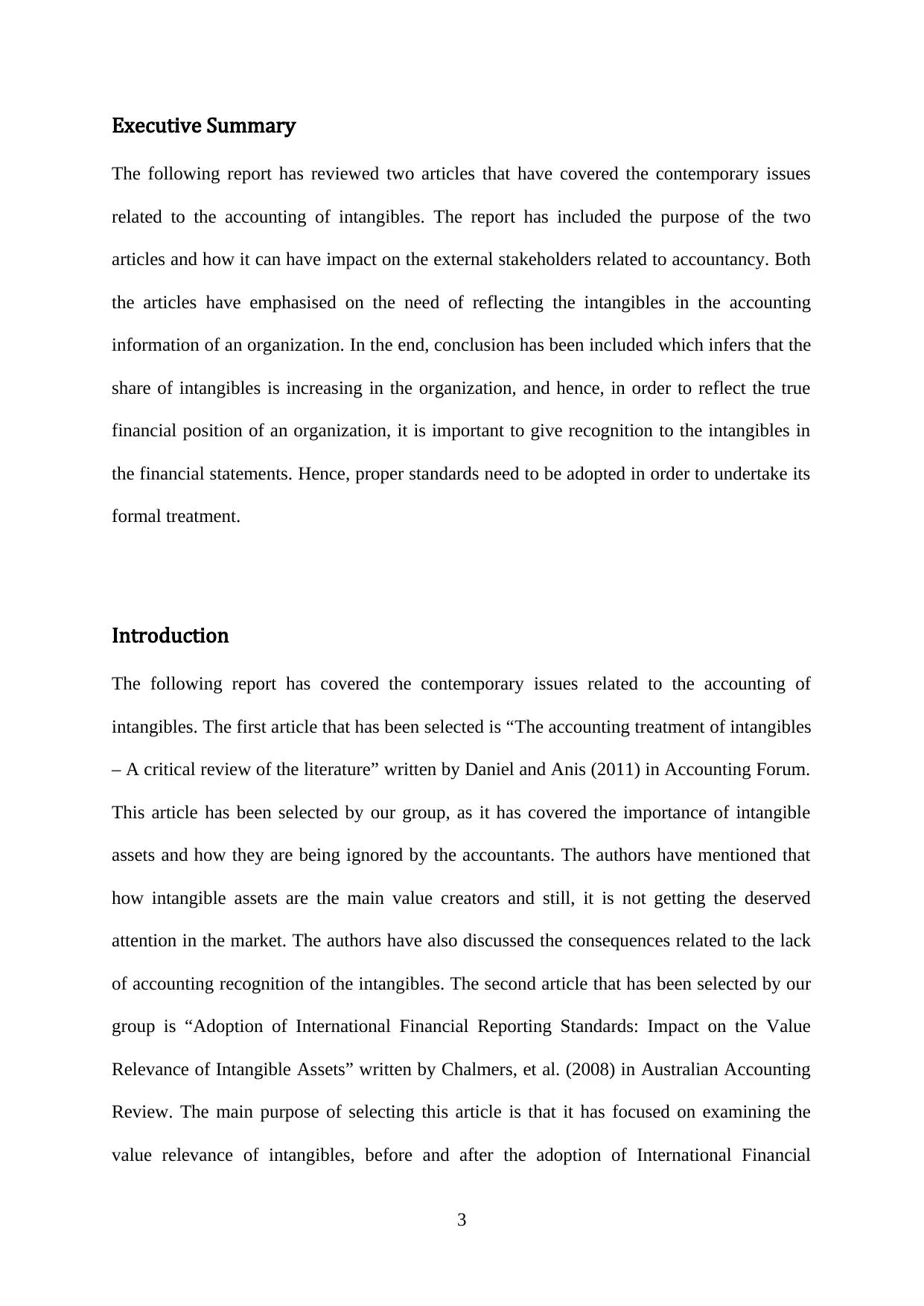
Executive Summary
The following report has reviewed two articles that have covered the contemporary issues
related to the accounting of intangibles. The report has included the purpose of the two
articles and how it can have impact on the external stakeholders related to accountancy. Both
the articles have emphasised on the need of reflecting the intangibles in the accounting
information of an organization. In the end, conclusion has been included which infers that the
share of intangibles is increasing in the organization, and hence, in order to reflect the true
financial position of an organization, it is important to give recognition to the intangibles in
the financial statements. Hence, proper standards need to be adopted in order to undertake its
formal treatment.
Introduction
The following report has covered the contemporary issues related to the accounting of
intangibles. The first article that has been selected is “The accounting treatment of intangibles
– A critical review of the literature” written by Daniel and Anis (2011) in Accounting Forum.
This article has been selected by our group, as it has covered the importance of intangible
assets and how they are being ignored by the accountants. The authors have mentioned that
how intangible assets are the main value creators and still, it is not getting the deserved
attention in the market. The authors have also discussed the consequences related to the lack
of accounting recognition of the intangibles. The second article that has been selected by our
group is “Adoption of International Financial Reporting Standards: Impact on the Value
Relevance of Intangible Assets” written by Chalmers, et al. (2008) in Australian Accounting
Review. The main purpose of selecting this article is that it has focused on examining the
value relevance of intangibles, before and after the adoption of International Financial
3
The following report has reviewed two articles that have covered the contemporary issues
related to the accounting of intangibles. The report has included the purpose of the two
articles and how it can have impact on the external stakeholders related to accountancy. Both
the articles have emphasised on the need of reflecting the intangibles in the accounting
information of an organization. In the end, conclusion has been included which infers that the
share of intangibles is increasing in the organization, and hence, in order to reflect the true
financial position of an organization, it is important to give recognition to the intangibles in
the financial statements. Hence, proper standards need to be adopted in order to undertake its
formal treatment.
Introduction
The following report has covered the contemporary issues related to the accounting of
intangibles. The first article that has been selected is “The accounting treatment of intangibles
– A critical review of the literature” written by Daniel and Anis (2011) in Accounting Forum.
This article has been selected by our group, as it has covered the importance of intangible
assets and how they are being ignored by the accountants. The authors have mentioned that
how intangible assets are the main value creators and still, it is not getting the deserved
attention in the market. The authors have also discussed the consequences related to the lack
of accounting recognition of the intangibles. The second article that has been selected by our
group is “Adoption of International Financial Reporting Standards: Impact on the Value
Relevance of Intangible Assets” written by Chalmers, et al. (2008) in Australian Accounting
Review. The main purpose of selecting this article is that it has focused on examining the
value relevance of intangibles, before and after the adoption of International Financial
3
⊘ This is a preview!⊘
Do you want full access?
Subscribe today to unlock all pages.

Trusted by 1+ million students worldwide
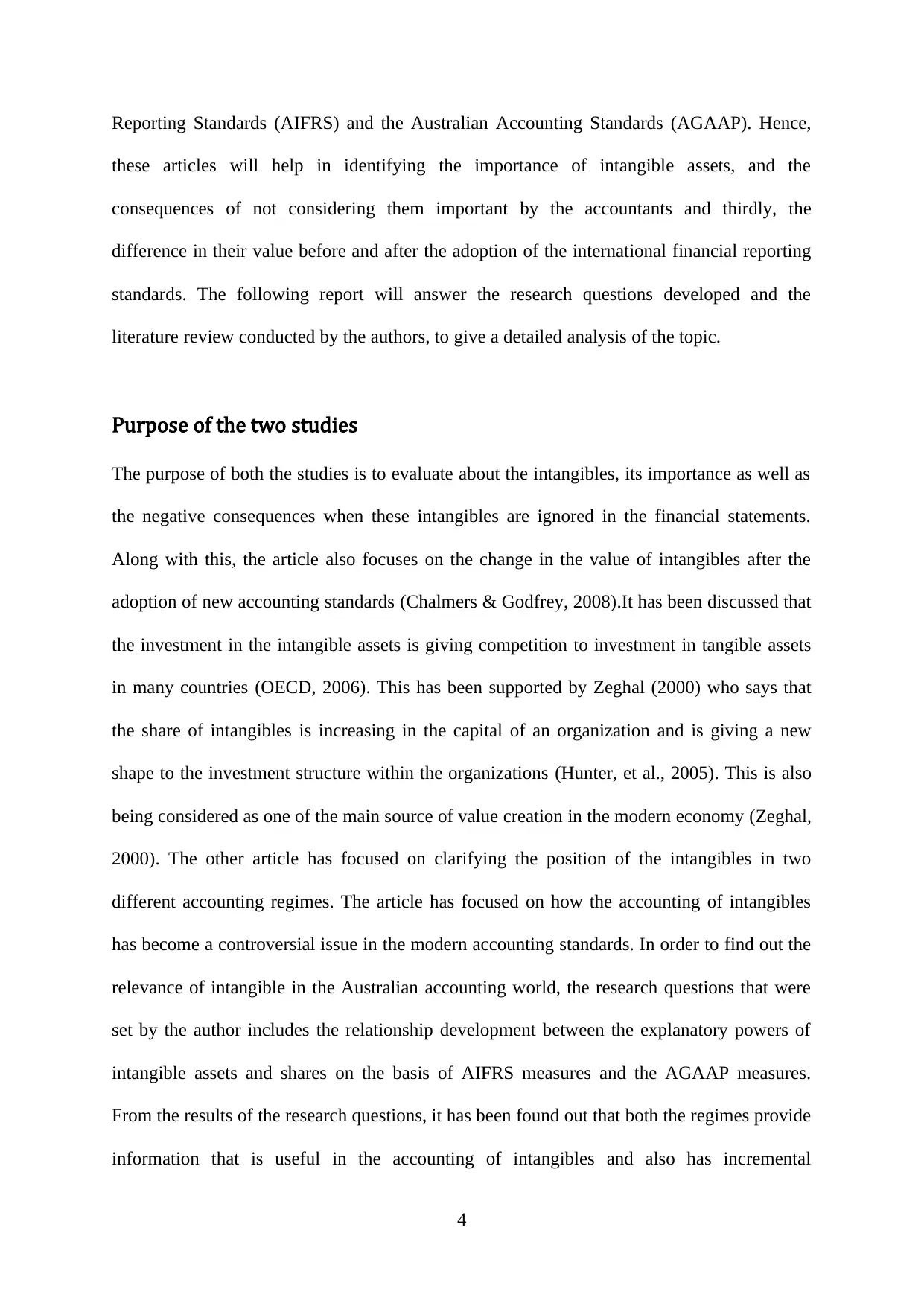
Reporting Standards (AIFRS) and the Australian Accounting Standards (AGAAP). Hence,
these articles will help in identifying the importance of intangible assets, and the
consequences of not considering them important by the accountants and thirdly, the
difference in their value before and after the adoption of the international financial reporting
standards. The following report will answer the research questions developed and the
literature review conducted by the authors, to give a detailed analysis of the topic.
Purpose of the two studies
The purpose of both the studies is to evaluate about the intangibles, its importance as well as
the negative consequences when these intangibles are ignored in the financial statements.
Along with this, the article also focuses on the change in the value of intangibles after the
adoption of new accounting standards (Chalmers & Godfrey, 2008).It has been discussed that
the investment in the intangible assets is giving competition to investment in tangible assets
in many countries (OECD, 2006). This has been supported by Zeghal (2000) who says that
the share of intangibles is increasing in the capital of an organization and is giving a new
shape to the investment structure within the organizations (Hunter, et al., 2005). This is also
being considered as one of the main source of value creation in the modern economy (Zeghal,
2000). The other article has focused on clarifying the position of the intangibles in two
different accounting regimes. The article has focused on how the accounting of intangibles
has become a controversial issue in the modern accounting standards. In order to find out the
relevance of intangible in the Australian accounting world, the research questions that were
set by the author includes the relationship development between the explanatory powers of
intangible assets and shares on the basis of AIFRS measures and the AGAAP measures.
From the results of the research questions, it has been found out that both the regimes provide
information that is useful in the accounting of intangibles and also has incremental
4
these articles will help in identifying the importance of intangible assets, and the
consequences of not considering them important by the accountants and thirdly, the
difference in their value before and after the adoption of the international financial reporting
standards. The following report will answer the research questions developed and the
literature review conducted by the authors, to give a detailed analysis of the topic.
Purpose of the two studies
The purpose of both the studies is to evaluate about the intangibles, its importance as well as
the negative consequences when these intangibles are ignored in the financial statements.
Along with this, the article also focuses on the change in the value of intangibles after the
adoption of new accounting standards (Chalmers & Godfrey, 2008).It has been discussed that
the investment in the intangible assets is giving competition to investment in tangible assets
in many countries (OECD, 2006). This has been supported by Zeghal (2000) who says that
the share of intangibles is increasing in the capital of an organization and is giving a new
shape to the investment structure within the organizations (Hunter, et al., 2005). This is also
being considered as one of the main source of value creation in the modern economy (Zeghal,
2000). The other article has focused on clarifying the position of the intangibles in two
different accounting regimes. The article has focused on how the accounting of intangibles
has become a controversial issue in the modern accounting standards. In order to find out the
relevance of intangible in the Australian accounting world, the research questions that were
set by the author includes the relationship development between the explanatory powers of
intangible assets and shares on the basis of AIFRS measures and the AGAAP measures.
From the results of the research questions, it has been found out that both the regimes provide
information that is useful in the accounting of intangibles and also has incremental
4
Paraphrase This Document
Need a fresh take? Get an instant paraphrase of this document with our AI Paraphraser
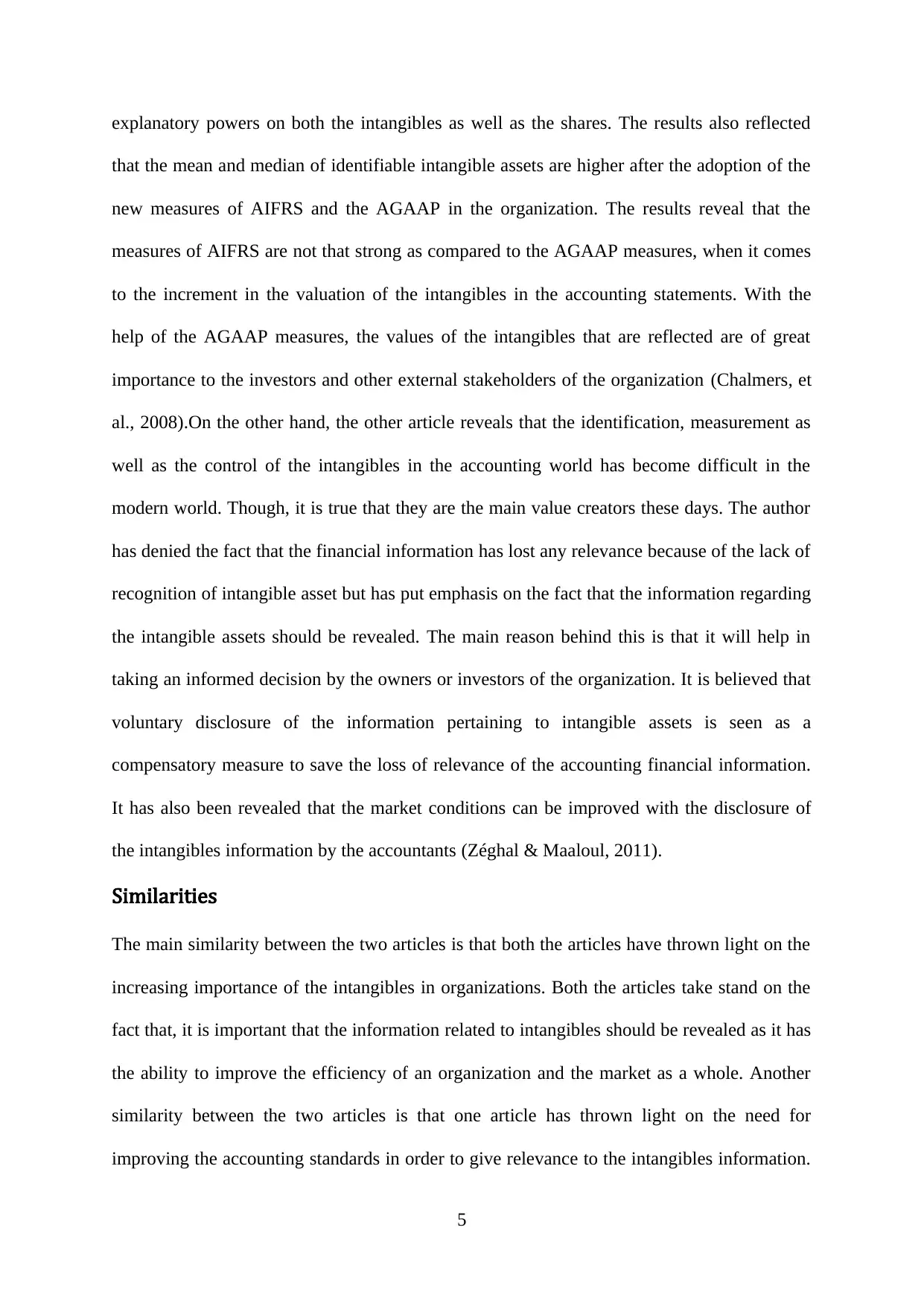
explanatory powers on both the intangibles as well as the shares. The results also reflected
that the mean and median of identifiable intangible assets are higher after the adoption of the
new measures of AIFRS and the AGAAP in the organization. The results reveal that the
measures of AIFRS are not that strong as compared to the AGAAP measures, when it comes
to the increment in the valuation of the intangibles in the accounting statements. With the
help of the AGAAP measures, the values of the intangibles that are reflected are of great
importance to the investors and other external stakeholders of the organization (Chalmers, et
al., 2008).On the other hand, the other article reveals that the identification, measurement as
well as the control of the intangibles in the accounting world has become difficult in the
modern world. Though, it is true that they are the main value creators these days. The author
has denied the fact that the financial information has lost any relevance because of the lack of
recognition of intangible asset but has put emphasis on the fact that the information regarding
the intangible assets should be revealed. The main reason behind this is that it will help in
taking an informed decision by the owners or investors of the organization. It is believed that
voluntary disclosure of the information pertaining to intangible assets is seen as a
compensatory measure to save the loss of relevance of the accounting financial information.
It has also been revealed that the market conditions can be improved with the disclosure of
the intangibles information by the accountants (Zéghal & Maaloul, 2011).
Similarities
The main similarity between the two articles is that both the articles have thrown light on the
increasing importance of the intangibles in organizations. Both the articles take stand on the
fact that, it is important that the information related to intangibles should be revealed as it has
the ability to improve the efficiency of an organization and the market as a whole. Another
similarity between the two articles is that one article has thrown light on the need for
improving the accounting standards in order to give relevance to the intangibles information.
5
that the mean and median of identifiable intangible assets are higher after the adoption of the
new measures of AIFRS and the AGAAP in the organization. The results reveal that the
measures of AIFRS are not that strong as compared to the AGAAP measures, when it comes
to the increment in the valuation of the intangibles in the accounting statements. With the
help of the AGAAP measures, the values of the intangibles that are reflected are of great
importance to the investors and other external stakeholders of the organization (Chalmers, et
al., 2008).On the other hand, the other article reveals that the identification, measurement as
well as the control of the intangibles in the accounting world has become difficult in the
modern world. Though, it is true that they are the main value creators these days. The author
has denied the fact that the financial information has lost any relevance because of the lack of
recognition of intangible asset but has put emphasis on the fact that the information regarding
the intangible assets should be revealed. The main reason behind this is that it will help in
taking an informed decision by the owners or investors of the organization. It is believed that
voluntary disclosure of the information pertaining to intangible assets is seen as a
compensatory measure to save the loss of relevance of the accounting financial information.
It has also been revealed that the market conditions can be improved with the disclosure of
the intangibles information by the accountants (Zéghal & Maaloul, 2011).
Similarities
The main similarity between the two articles is that both the articles have thrown light on the
increasing importance of the intangibles in organizations. Both the articles take stand on the
fact that, it is important that the information related to intangibles should be revealed as it has
the ability to improve the efficiency of an organization and the market as a whole. Another
similarity between the two articles is that one article has thrown light on the need for
improving the accounting standards in order to give relevance to the intangibles information.
5
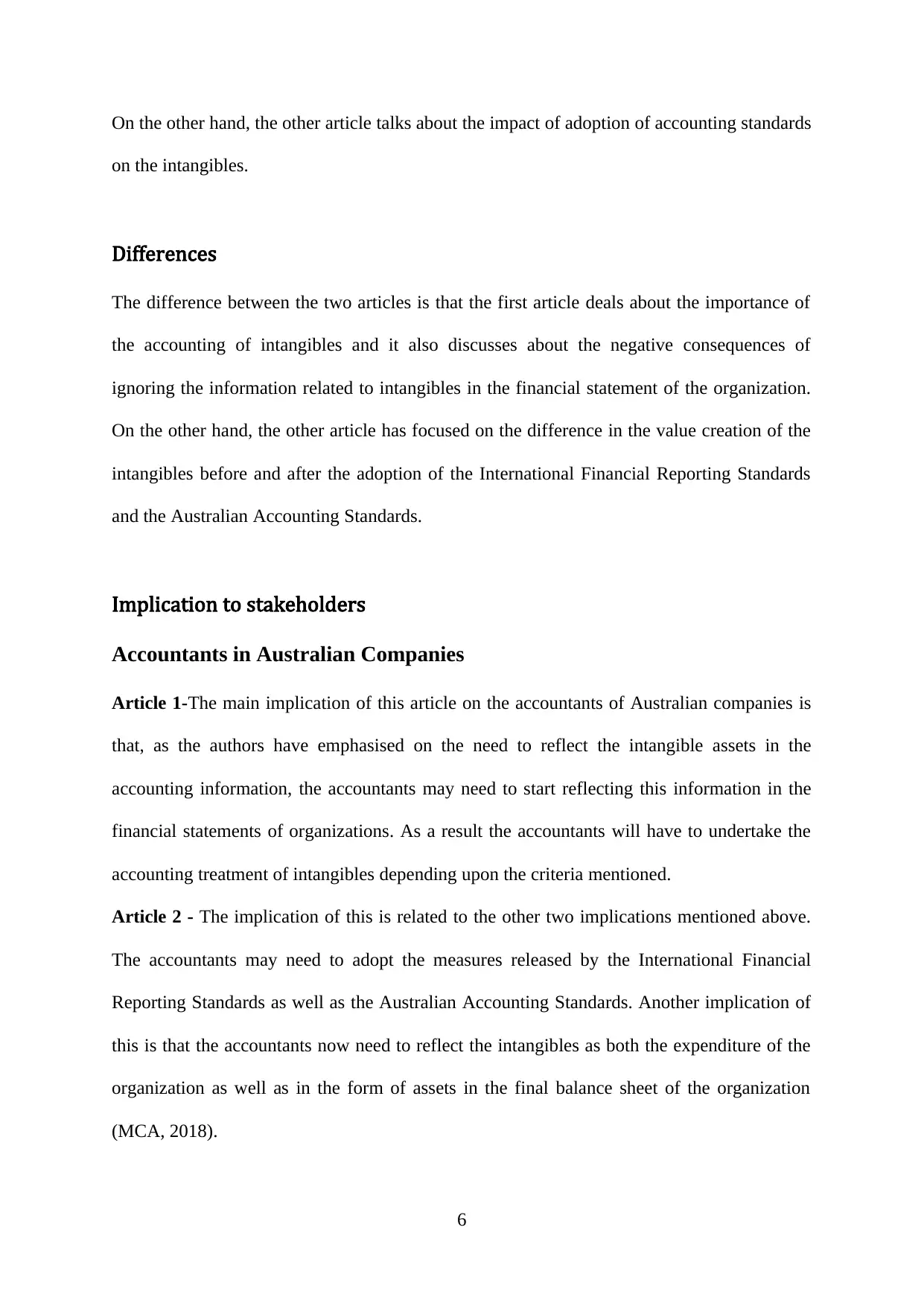
On the other hand, the other article talks about the impact of adoption of accounting standards
on the intangibles.
Differences
The difference between the two articles is that the first article deals about the importance of
the accounting of intangibles and it also discusses about the negative consequences of
ignoring the information related to intangibles in the financial statement of the organization.
On the other hand, the other article has focused on the difference in the value creation of the
intangibles before and after the adoption of the International Financial Reporting Standards
and the Australian Accounting Standards.
Implication to stakeholders
Accountants in Australian Companies
Article 1-The main implication of this article on the accountants of Australian companies is
that, as the authors have emphasised on the need to reflect the intangible assets in the
accounting information, the accountants may need to start reflecting this information in the
financial statements of organizations. As a result the accountants will have to undertake the
accounting treatment of intangibles depending upon the criteria mentioned.
Article 2 - The implication of this is related to the other two implications mentioned above.
The accountants may need to adopt the measures released by the International Financial
Reporting Standards as well as the Australian Accounting Standards. Another implication of
this is that the accountants now need to reflect the intangibles as both the expenditure of the
organization as well as in the form of assets in the final balance sheet of the organization
(MCA, 2018).
6
on the intangibles.
Differences
The difference between the two articles is that the first article deals about the importance of
the accounting of intangibles and it also discusses about the negative consequences of
ignoring the information related to intangibles in the financial statement of the organization.
On the other hand, the other article has focused on the difference in the value creation of the
intangibles before and after the adoption of the International Financial Reporting Standards
and the Australian Accounting Standards.
Implication to stakeholders
Accountants in Australian Companies
Article 1-The main implication of this article on the accountants of Australian companies is
that, as the authors have emphasised on the need to reflect the intangible assets in the
accounting information, the accountants may need to start reflecting this information in the
financial statements of organizations. As a result the accountants will have to undertake the
accounting treatment of intangibles depending upon the criteria mentioned.
Article 2 - The implication of this is related to the other two implications mentioned above.
The accountants may need to adopt the measures released by the International Financial
Reporting Standards as well as the Australian Accounting Standards. Another implication of
this is that the accountants now need to reflect the intangibles as both the expenditure of the
organization as well as in the form of assets in the final balance sheet of the organization
(MCA, 2018).
6
⊘ This is a preview!⊘
Do you want full access?
Subscribe today to unlock all pages.

Trusted by 1+ million students worldwide
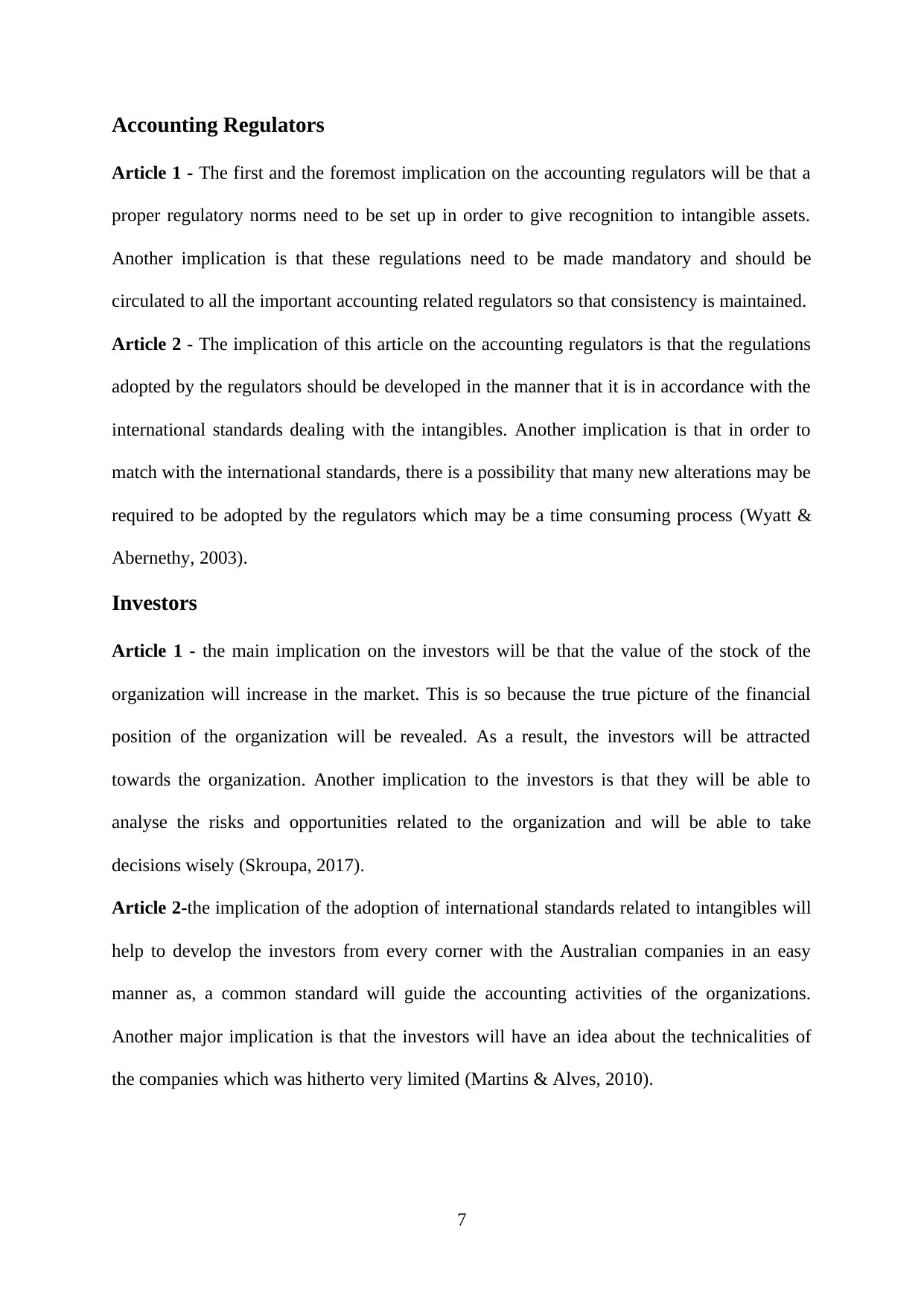
Accounting Regulators
Article 1 - The first and the foremost implication on the accounting regulators will be that a
proper regulatory norms need to be set up in order to give recognition to intangible assets.
Another implication is that these regulations need to be made mandatory and should be
circulated to all the important accounting related regulators so that consistency is maintained.
Article 2 - The implication of this article on the accounting regulators is that the regulations
adopted by the regulators should be developed in the manner that it is in accordance with the
international standards dealing with the intangibles. Another implication is that in order to
match with the international standards, there is a possibility that many new alterations may be
required to be adopted by the regulators which may be a time consuming process (Wyatt &
Abernethy, 2003).
Investors
Article 1 - the main implication on the investors will be that the value of the stock of the
organization will increase in the market. This is so because the true picture of the financial
position of the organization will be revealed. As a result, the investors will be attracted
towards the organization. Another implication to the investors is that they will be able to
analyse the risks and opportunities related to the organization and will be able to take
decisions wisely (Skroupa, 2017).
Article 2-the implication of the adoption of international standards related to intangibles will
help to develop the investors from every corner with the Australian companies in an easy
manner as, a common standard will guide the accounting activities of the organizations.
Another major implication is that the investors will have an idea about the technicalities of
the companies which was hitherto very limited (Martins & Alves, 2010).
7
Article 1 - The first and the foremost implication on the accounting regulators will be that a
proper regulatory norms need to be set up in order to give recognition to intangible assets.
Another implication is that these regulations need to be made mandatory and should be
circulated to all the important accounting related regulators so that consistency is maintained.
Article 2 - The implication of this article on the accounting regulators is that the regulations
adopted by the regulators should be developed in the manner that it is in accordance with the
international standards dealing with the intangibles. Another implication is that in order to
match with the international standards, there is a possibility that many new alterations may be
required to be adopted by the regulators which may be a time consuming process (Wyatt &
Abernethy, 2003).
Investors
Article 1 - the main implication on the investors will be that the value of the stock of the
organization will increase in the market. This is so because the true picture of the financial
position of the organization will be revealed. As a result, the investors will be attracted
towards the organization. Another implication to the investors is that they will be able to
analyse the risks and opportunities related to the organization and will be able to take
decisions wisely (Skroupa, 2017).
Article 2-the implication of the adoption of international standards related to intangibles will
help to develop the investors from every corner with the Australian companies in an easy
manner as, a common standard will guide the accounting activities of the organizations.
Another major implication is that the investors will have an idea about the technicalities of
the companies which was hitherto very limited (Martins & Alves, 2010).
7
Paraphrase This Document
Need a fresh take? Get an instant paraphrase of this document with our AI Paraphraser
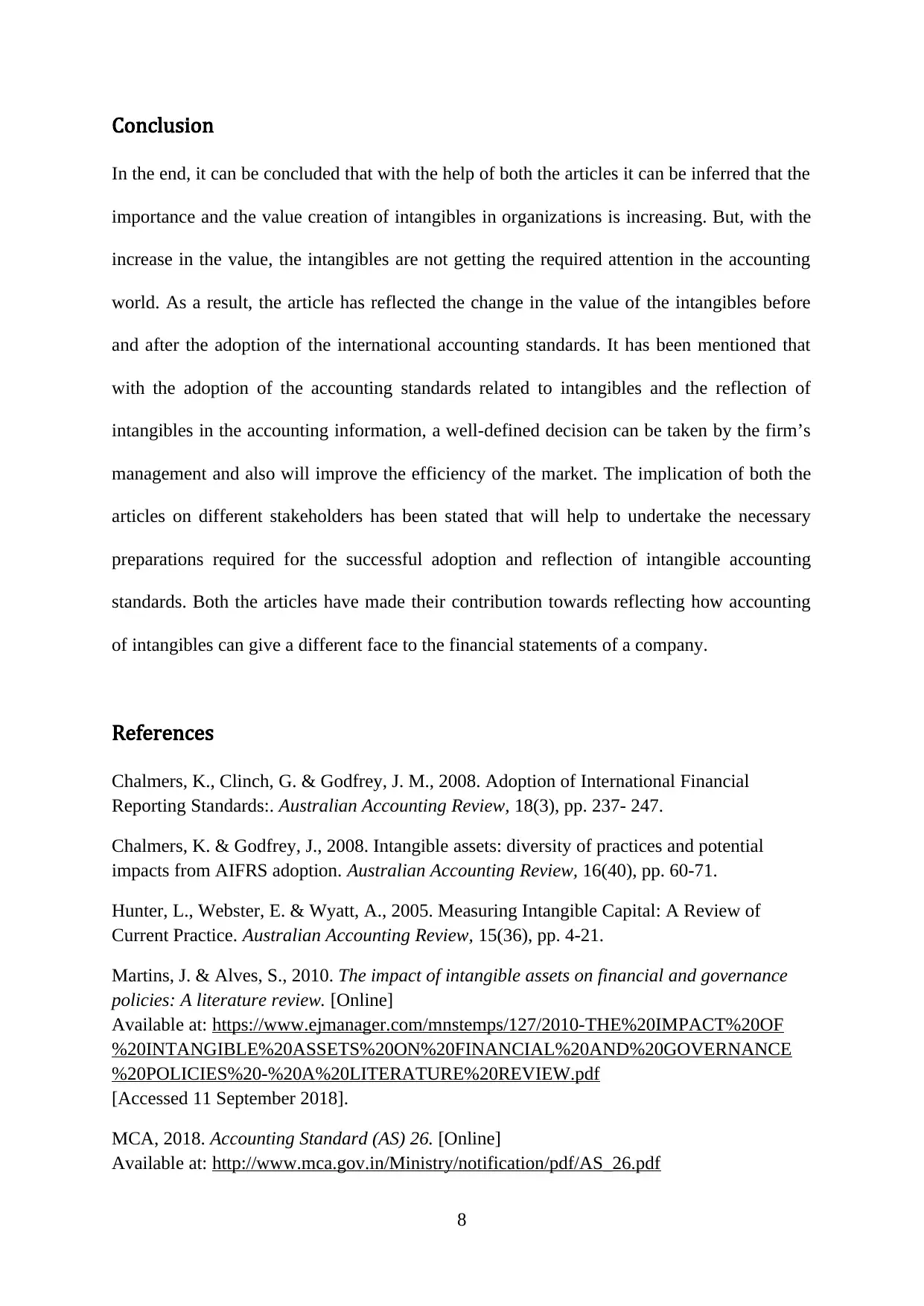
Conclusion
In the end, it can be concluded that with the help of both the articles it can be inferred that the
importance and the value creation of intangibles in organizations is increasing. But, with the
increase in the value, the intangibles are not getting the required attention in the accounting
world. As a result, the article has reflected the change in the value of the intangibles before
and after the adoption of the international accounting standards. It has been mentioned that
with the adoption of the accounting standards related to intangibles and the reflection of
intangibles in the accounting information, a well-defined decision can be taken by the firm’s
management and also will improve the efficiency of the market. The implication of both the
articles on different stakeholders has been stated that will help to undertake the necessary
preparations required for the successful adoption and reflection of intangible accounting
standards. Both the articles have made their contribution towards reflecting how accounting
of intangibles can give a different face to the financial statements of a company.
References
Chalmers, K., Clinch, G. & Godfrey, J. M., 2008. Adoption of International Financial
Reporting Standards:. Australian Accounting Review, 18(3), pp. 237- 247.
Chalmers, K. & Godfrey, J., 2008. Intangible assets: diversity of practices and potential
impacts from AIFRS adoption. Australian Accounting Review, 16(40), pp. 60-71.
Hunter, L., Webster, E. & Wyatt, A., 2005. Measuring Intangible Capital: A Review of
Current Practice. Australian Accounting Review, 15(36), pp. 4-21.
Martins, J. & Alves, S., 2010. The impact of intangible assets on financial and governance
policies: A literature review. [Online]
Available at: https://www.ejmanager.com/mnstemps/127/2010-THE%20IMPACT%20OF
%20INTANGIBLE%20ASSETS%20ON%20FINANCIAL%20AND%20GOVERNANCE
%20POLICIES%20-%20A%20LITERATURE%20REVIEW.pdf
[Accessed 11 September 2018].
MCA, 2018. Accounting Standard (AS) 26. [Online]
Available at: http://www.mca.gov.in/Ministry/notification/pdf/AS_26.pdf
8
In the end, it can be concluded that with the help of both the articles it can be inferred that the
importance and the value creation of intangibles in organizations is increasing. But, with the
increase in the value, the intangibles are not getting the required attention in the accounting
world. As a result, the article has reflected the change in the value of the intangibles before
and after the adoption of the international accounting standards. It has been mentioned that
with the adoption of the accounting standards related to intangibles and the reflection of
intangibles in the accounting information, a well-defined decision can be taken by the firm’s
management and also will improve the efficiency of the market. The implication of both the
articles on different stakeholders has been stated that will help to undertake the necessary
preparations required for the successful adoption and reflection of intangible accounting
standards. Both the articles have made their contribution towards reflecting how accounting
of intangibles can give a different face to the financial statements of a company.
References
Chalmers, K., Clinch, G. & Godfrey, J. M., 2008. Adoption of International Financial
Reporting Standards:. Australian Accounting Review, 18(3), pp. 237- 247.
Chalmers, K. & Godfrey, J., 2008. Intangible assets: diversity of practices and potential
impacts from AIFRS adoption. Australian Accounting Review, 16(40), pp. 60-71.
Hunter, L., Webster, E. & Wyatt, A., 2005. Measuring Intangible Capital: A Review of
Current Practice. Australian Accounting Review, 15(36), pp. 4-21.
Martins, J. & Alves, S., 2010. The impact of intangible assets on financial and governance
policies: A literature review. [Online]
Available at: https://www.ejmanager.com/mnstemps/127/2010-THE%20IMPACT%20OF
%20INTANGIBLE%20ASSETS%20ON%20FINANCIAL%20AND%20GOVERNANCE
%20POLICIES%20-%20A%20LITERATURE%20REVIEW.pdf
[Accessed 11 September 2018].
MCA, 2018. Accounting Standard (AS) 26. [Online]
Available at: http://www.mca.gov.in/Ministry/notification/pdf/AS_26.pdf
8
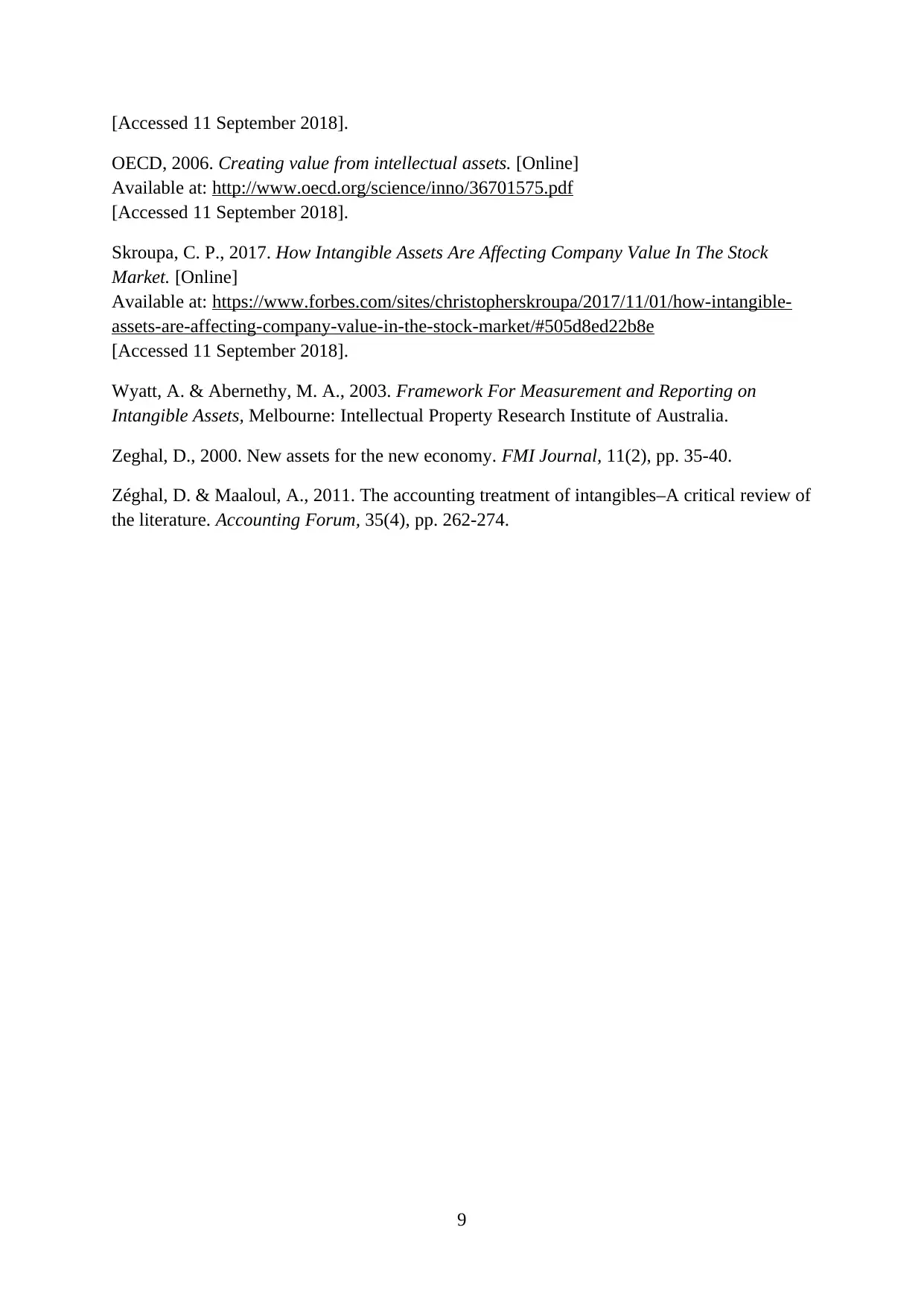
[Accessed 11 September 2018].
OECD, 2006. Creating value from intellectual assets. [Online]
Available at: http://www.oecd.org/science/inno/36701575.pdf
[Accessed 11 September 2018].
Skroupa, C. P., 2017. How Intangible Assets Are Affecting Company Value In The Stock
Market. [Online]
Available at: https://www.forbes.com/sites/christopherskroupa/2017/11/01/how-intangible-
assets-are-affecting-company-value-in-the-stock-market/#505d8ed22b8e
[Accessed 11 September 2018].
Wyatt, A. & Abernethy, M. A., 2003. Framework For Measurement and Reporting on
Intangible Assets, Melbourne: Intellectual Property Research Institute of Australia.
Zeghal, D., 2000. New assets for the new economy. FMI Journal, 11(2), pp. 35-40.
Zéghal, D. & Maaloul, A., 2011. The accounting treatment of intangibles–A critical review of
the literature. Accounting Forum, 35(4), pp. 262-274.
9
OECD, 2006. Creating value from intellectual assets. [Online]
Available at: http://www.oecd.org/science/inno/36701575.pdf
[Accessed 11 September 2018].
Skroupa, C. P., 2017. How Intangible Assets Are Affecting Company Value In The Stock
Market. [Online]
Available at: https://www.forbes.com/sites/christopherskroupa/2017/11/01/how-intangible-
assets-are-affecting-company-value-in-the-stock-market/#505d8ed22b8e
[Accessed 11 September 2018].
Wyatt, A. & Abernethy, M. A., 2003. Framework For Measurement and Reporting on
Intangible Assets, Melbourne: Intellectual Property Research Institute of Australia.
Zeghal, D., 2000. New assets for the new economy. FMI Journal, 11(2), pp. 35-40.
Zéghal, D. & Maaloul, A., 2011. The accounting treatment of intangibles–A critical review of
the literature. Accounting Forum, 35(4), pp. 262-274.
9
⊘ This is a preview!⊘
Do you want full access?
Subscribe today to unlock all pages.

Trusted by 1+ million students worldwide
1 out of 9
Related Documents
Your All-in-One AI-Powered Toolkit for Academic Success.
+13062052269
info@desklib.com
Available 24*7 on WhatsApp / Email
![[object Object]](/_next/static/media/star-bottom.7253800d.svg)
Unlock your academic potential
Copyright © 2020–2025 A2Z Services. All Rights Reserved. Developed and managed by ZUCOL.




